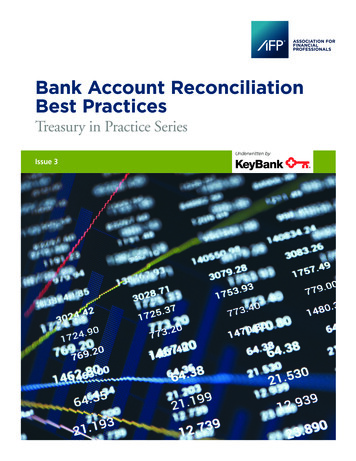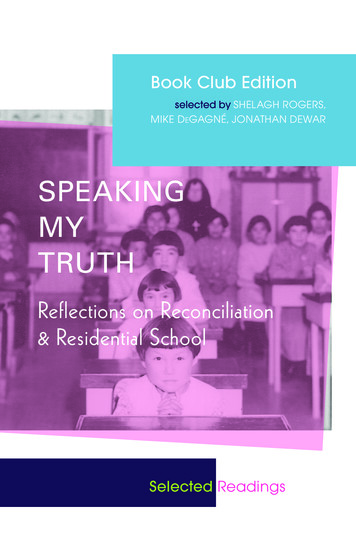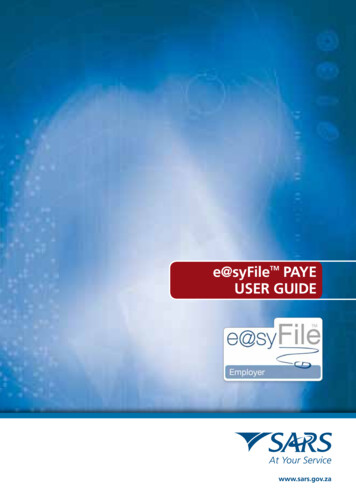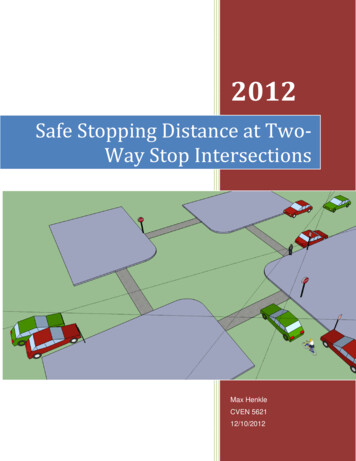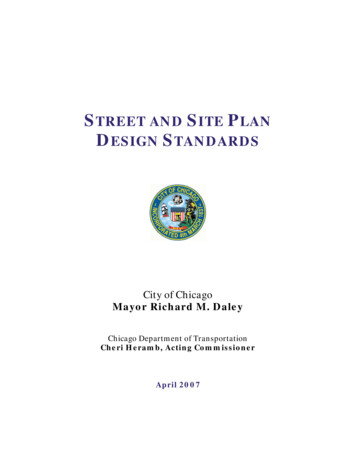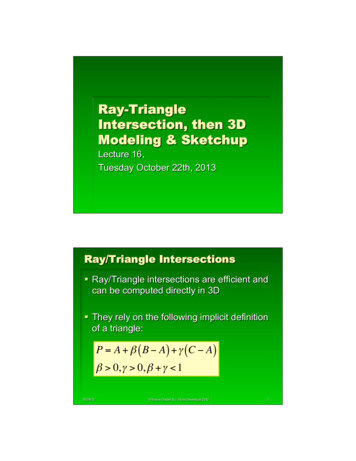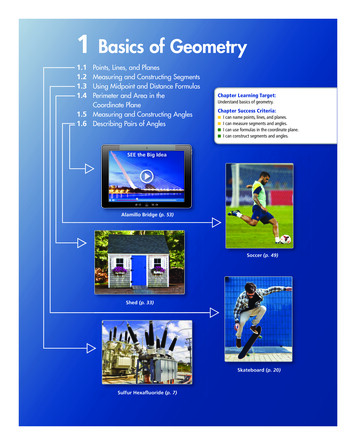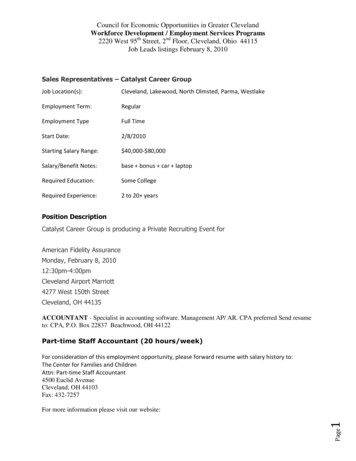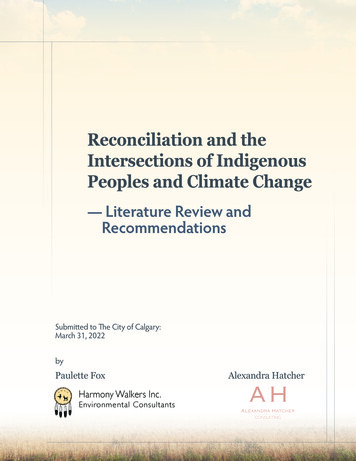
Transcription
Reconciliation and theIntersections of IndigenousPeoples and Climate Change — Literature Review andRecommendationsSubmitted to The City of Calgary:March 31, 2022byPaulette FoxHarmony Walkers Inc.Environmental ConsultantsAlexandra Hatcher
Table of ContentsExecutive Summary.4Introduction.5A. Ways of Knowing.6B. Ways of Engaging .13Cross-cutting and Multi-scalar Climate Issues,Constraints and Opportunities: Case Study Review.14Case Study I: Siksika - Risk, Recovery, and Resilience.14Case Study II: Policy Analysis.15Case Study III: Grassroots Leadership.16C. Ways of Building Relationships.17D. Ways toward Equitable Environments.20Summary, Conclusions and Recommendations.21Thematic Analysis and Synthesis: Literature Review & Case Studies.22Equitable Environments and Ethical Space Dialogue.23References.26Selected Annotated Bibliography.30APPENDIX A.33APPENDIX B.34List of Consultation Contacts.35
The Calgary area where the Bow and Elbow Rivers meet is a place ofconfluence where the sharing of ideas and opportunities naturally cometogether. Indigenous Peoples have their own names for this area that havebeen in use long before Scottish settlers named this place Calgary. In theBlackfoot language, Moh’kinsstis; in Stoney Nakoda language, WîchîskpaOyade, and the Tsuut’ina language, Guts-ists-i. The Métis word for Calgaryis Otos-kwunee.We would like to acknowledge that this project is located on the traditionalterritories of the Blackfoot and Treaty 7 First Nations in Southern Alberta.This includes: the Siksika, Piikani, and Kainai collectively known as theBlackfoot Confederacy, along with the Blackfeet in Montana; the ÎethkaNakoda Wîcastabi First Nations, comprised of the Chiniki, Bearspaw, andWesley First Nations; and the Tsuut’ina First Nation. The city of Calgary isnow also home to Northwest Métis and to Métis Nation of Alberta Region3, Indigenous urban Calgarians, First Nations, Inuit, and Métis, who havemade Calgary their home.Reconciliation and the Intersections of Indigenous Peoples and Climate Change3
Reconciliation and the Intersections ofIndigenous Peoples and Climate Change — Literature Review and RecommendationsExecutive SummaryIncreasing uncertainty and frequency related to weather extremes caused by human induced climatechange will continue to adversely affect all sectors of society. Damages from the 2021 floods, firesand pandemic may not even be calculated. Meanwhile, costs related to the 2013 floods totallingapproximately 6 billion (City of Calgary, nd) offer a forecast for what we can expect in the comingdecades for the City of Calgary. Unfortunately, this doesn’t include the incalculable costs related tomental health and well-being aspects associated with climate displacement as research and resourcesremain limited to physical impacts.Numerous domestic and international reports and commissions point to the need to includeIndigenous Peoples, not only through the lens or scope of mainstream frameworks, but from their ownknowledge systems. Increasingly, Ethical Space and other Indigenous-led holistic approaches are emergingto support this principle of inclusion of Indigenous Traditional Knowledge through appropriateprocesses that do not marginalize the people whom the knowledge belongs. The intersections ofIndigenous Peoples and climate change, remain complex and there is an important call to decolonizeclimate policy.Indigenous Peoples have been experiencing and witnessing the cumulative effects of industrialization andhuman-induced climate change, and after several decades of sounding the alarm bells, barriers toinclusion through colonial interests, have led to disparities, inequities, and injustices (Little Bear, 2000).Several reports indicate that Indigenous Peoples disproportionality bare the brunt of these cascadingimpacts (United Nations, 2018) and are affected in ways that impact the ability to practice treaty andother rights, among other things, as well as pass down vital oral customs and traditions.Anchoring inclusion of Indigenous Peoples from Treaty 7 First Nations, the Blackfoot Confederacyand urban First Nation, Inuit, and Métis people through a Distinctions-Based approach for The Citybuilds on the commitment to fostering equitable environments through early engagement and action.Listening to and learning from diverse cultures and languages brings about the importance of bothbiological and cultural diversity across ecosystems and the need to restore Biocultural Diversity (Maffi2014; Davidson-Hunt 2012). Through Ethical Space principles, and other Indigenous-led conceptsand approaches, this report provides key considerations for grounding climate strategies and actionsin reconciliation.Reconciliation and the Intersections of Indigenous Peoples and Climate Change4
IntroductionGlobally, Indigenous Peoples protect 80% of the world’s biodiversity but comprise less than fivepercent of the population (United Nations Environment Program [UNEP], 2017). Rooted in a holisticBiocultural Diversity (Maffi 2014; Davidson-Hunt 2012) worldview where everything is connected,and everything is one, what is it about the relationship between Indigenous Peoples and the land thatresults in such positive sustainable outcomes? Moreover, how can these relationships inform climatepolicy at the City of Calgary in the spirit and intent of Reconciliation? The following report drawson the notions of Intersectional Policy-based Analysis (IPBA), as well as Indigenous-led conceptsand approaches to explore cross-cutting themes, including challenges and opportunities for puttingreconciliation into climate action.The intersections of Indigenous Peoples and human-induced climate change are complex, andthere remain significant gaps in knowledge, policy and practice at various scales and levels. Formany First Nations, Inuit, and Métis communities, it is difficult to have a conversation about climatechange without discussing the impacts of colonization. The root causes are connected and thereis an important call to decolonize climate policy. Anchoring inclusion of Indigenous Peoples fromTreaty 7 First Nations, the Blackfoot Confederacy and urban First Nation, Inuit, and Métis peoplethrough a Distinctions Based approach for The City builds on the commitment to fostering equitableenvironments through early engagement and action. Listening to and learning from diverse culturesand languages brings about the importance of both biological and cultural diversity across ecosystemsand the need to restore the Biocultural Diversity (Maffi 2014; Davidson-Hunt 2012).Through this Literature Review, two questions will be explored: 1) How can The City’s Climate ActionStrategy and Action Plans respect, support, and use Indigenous Traditional Ecological Knowledge? and2) How can The City engage Indigenous Peoples through Climate Action Strategy and Action Planstowards equitable and inclusive environments?This report utilizes the Four Ways Forward as outlined in the City of Calgary’s Indigenous PolicyFramework (IPF) as guideposts to structure critical themes emerging from the literature. Including:A) Ways of Knowing, B) Ways of Engaging, C) Ways of Building Relationships, and D)Ways Toward Equitable Environments. In Part A, Indigenous-led concepts and approaches arepresented to help frame Indigenous ways of knowing including understanding the vital relationshipsand connections Indigenous peoples have to the land. From here, in Part B we dive into case studiesthat are intended to guide conversations related to meaningful engagement. In Part C and D we focuson Indigenous-led innovations and sustainable solutions. Through Ethical Space principles, and otherIndigenous-led concepts and approaches, this report provides key considerations for groundingclimate strategies and actions in reconciliation.Reconciliation and the Intersections of Indigenous Peoples and Climate Change5
A. Ways of KnowingIndigenous Peoples have been experiencing and witnessing the cumulative effects of industrializationand human-induced climate change, and after several decades of sounding the alarm bells, barriersto inclusion through colonial interests, have led to disparities, inequities, and injustices (Little Bear,2000). Several reports indicate that Indigenous Peoples disproportionality bare the brunt of thesecascading impacts (UNEP, 2017), and are affected in ways that impact the ability to practice treatyand other rights, among other things, including passing down vital oral customs and traditions. Sciencealone cannot address the issues surrounding human-induced climate change and the rapid loss ofbiodiversity, the two are inter-related.Utilizing the best available knowledge can be challenging as there are multiple ways of knowing in addition toscience. Drawing on the rich knowledge of Indigenous Peoples is key. However, simply putting Indigenousknowledge into science or mainstream frameworks falls short of the goals of stepping into reconciliation and theneed to step outside the parameters of science. Moreover, there is a meshwork of geo-polity, nation-making andbuilding, among other aspects, that contribute to the colonial context in Canada that may inhibit opportunitiesfor respectful weaving of Indigenous knowledge systems with multiples ways of knowing.Given all of this, how can respectful weaving of disparate knowledge systems occur? This section explores theintersections of Indigenous Peoples Ways of Knowing that includes vital Traditional Knowledge (TK) importantto address impacts associated with climate change. It sets out a critical pathway to understanding culturallyappropriate methodologies and Indigenous-led approaches necessary to understand complexities and addressgaps in knowledge, policy, and practice.Weaving Indigenous Knowledge and Multiple Ways of KnowingTo begin we recognize, through Ethical Space that Indigenous oral systems and western written systems representdisparate worldviews (Ermine, 2007). In addition, that each have equal weight and through Ethical space, one isnot subsumed into the other but viewed in parallel (Crowshoe & Littlechild, 2020). Dr. Reg Crowshoe, BlackfootElder, emphasizes that Ethical Space Dialogue is an important step for reconciliation towards equitable andjust outcomes for Indigenous Peoples. In addition, the concept of ethical space is complimentary to the Mi’kmaqnotion of Two-eyed Seeing (Marshall et al, 2015, Bartlett et al, 2015, Bartlett et al, 2012). As Mi’kmaq ElderAlbert Marshall shares that, Two-Eyed Seeing - Etuaptmumk is: “To see from one eye with the strengths ofIndigenous ways of knowing, and to see from the other eye with the strengths of Western ways of knowing, andto use both of these eyes together” (Bartlett et al, 2012, p. 335). He further illustrates the importance of colearning journey.In a similar fashion, these Indigenous concepts recognize the need to address critical Issues from both anIndigenous and western lens, towards actions and solutions. Not unlike Ethical Space and Two-eyed Seeing,Braiding Sweetgrass offers Insight to how we may further respectfully weave Indigenous and western waysof knowing. Through the use of analogy, Dr. Kimmerer a Potawatami Scholar describes the process of: planting,tending, picking, braiding and burning sweetgrass that support respectful weaving of knowledge systems andmultiple ways of knowing, including other-than-human worldviews (Kimmerer, 2015). For example, culturallyimportant, iconic and keystone species have an important view that also needs to be considered. In other words,if the land could speak, what concerns do you think would arise? Depending on the worldview, responses mayvary, but there may also be stark contrasts.Reconciliation and the Intersections of Indigenous Peoples and Climate Change6
Our languages are encoded on the landscape.(Goodchild in Paikin, 2018)Approaches such as science that consider culture and ecology as binaries, typically bifurcate and isolate processesad infinitum. This may include, among other things, climate adaption, risk and recovery regimes; expressed asdichotomies or dualistic approaches. Taken from an Indigenous worldview that is rooted in oral customs, theseparation of culture and ecology or humans and nature, does not occur. It is increasingly recognized thatlinguistic diversity and rich biologically diverse ecosystems highly correlate. As Melanie Goodchild, NASA’sIndigenous Scientist explains, “our languages are encoded on the landscape”, conveyed through Indigenousnorms and narratives (Goodchild in Paikin, 2018).There is increasing recognition that linguistic diversity and rich biologically diverse ecosystems highly correlate.Protecting the voices of Indigenous Peoples, whose cultures are founded upon lands, water, and wildlife, results inthe preservation of the entire social and ecological landscape upon which all people depend (Davidson-Hunt etal, 2012). Place-based knowing, as Indigenous scholar Cutcha Risling-Baldy describes, are seasonal connectionsto land, including the practice of “Gathering” (Ingold 1996), which she conveys through the context of BioculturalDiversity (Risling Baldy, 2012). For Indigenous societies, epistemologies and worldviews, Gathering is aboutrevitalization and continuing the interrelationships that go back in time and that have been built through culturaland spiritual interaction with the land. Indigenous Peoples do not separate themselves from the environment. Aconcept captured by the notion of Biocultural Diversity (Maffi 2014).Reconciliation with Indigenous Peoples and the Crownrequires our collective reconciliation with the Earth.The Truth and Reconciliation Commission Report (TRCC, 2015) calls on various levels of government in Canada,including municipalities, to actively step into reconciliation, and The City of Calgary is committed to puttingreconciliation into Action. In response to the TRC Principles and Calls to Action, The City of Calgary along withthe Calgary Aboriginal Urban Affairs Committee (CAUAC) developed the White Goose Flying Report and theIndigenous Policy Framework (IPF) to support implementation across the various Business Units throughout TheCorporation. Engaging Indigenous Peoples on policies and plans at the earliest stages as recommended by theIPF includes a holistic, systems-based approach. Working towards equitable environments, rooted in the uniqueperspectives and concerns from communities, listening to commonalities, and actively addressing concerns,supports The City of Calgary’s commitment to reconciliation.As Cameron (2012) articulates: “Climate change itself is thoroughly tied to colonial practices, both historicallyand in the present, insofar as greenhouse gas production over the last two centuries hinged on the dispossessionof indigenous lands and resources.” In other words, the economic factors driving resource extraction form thesame root causes associated with colonization of Indigenous Peoples lands and resources. Indeed, adaptation toimpacts of climate related vulnerability, risk and resilience cannot be detached from the context of colonialism(Norton-smith et al. 2016). There is a call to decolonize climate policy, notwithstanding the meshwork ofgeopolitical relationships, nation-making and building, among other aspects that contribute to the colonialcontext in Canada. Taken together, significantly inhibit opportunities for respectful weaving of Indigenousknowledge systems with multiples ways of knowing.For some, it is a matter of taking action such as the Indigenous Climate Action Network that aims to decolonizeReconciliation and the Intersections of Indigenous Peoples and Climate Change7
climate policy while supporting Indigenous-led solutions, among other actions (Indigenous Climate ActionNetwork, 2021). This makes sense, given that Indigenous Peoples have been sounding the alarm bells regardingour current climate situation for several decades. We have not moved the needle on addressing the disparitiesof colonialism and industrialization insofar as the two are deeply rooted in the same causes.This common ground, or common root, allows us to address and act in reconciliation when it comes toclimate change and Indigenous Peoples, not as separate actions but inextricably linked. Taking the root causesalong with the notion of sustainability, its inception and impetus points to what the most recent climatereports indicate: decades of inaction and lack of leadership have led to our current climate situation. Thus,“reconciliation between Indigenous Peoples and the Crown requires our collective reconciliation with the earth”(Borrows, 2018).Ethical Space Dialogue and Climate TablesIncreasingly, Ethical Space is being used by academics, researchers, policymakers, and practitioners acrossmultiple disciplines and sectors (Ermine, 2004; Crowshoe, 2014; Indigenous Circle of Experts (ICE), 2018;National Advisory Panel (NAP), 2017; Pan-Canadian Framework on Climate Change (PCFCC), 2017; amongothers). Given the disparate worldviews of Indigenous and western ways of knowing, Ethical Space becomes acollective agreement to base conversations in truth and honor the fiduciary relationship between IndigenousPeoples and the Crown (ICE, 2018), despite perceived differences and lends itself to a reconciliation processby recognizing our collective colonial past. Moreover, it is in alignment with the Delgamuukw decision (Lameret al, 1997) that was based on oral testimony, where Chief Justice Lamer emphasized the need for courts to cometo terms with oral customs. Ethical Space, in many ways is about coming to terms with Indigenous KnowledgeSystems and Traditional Ecological Knowledge (TEK).Figure 1. Ethical Space — spheres supporting shared values fromdisparate worldview and knowledge systems working in parallelFigure 1 illustrates the importance of distinguishing between knowledge systems and worldviews and cocreating common ground through shared values and principles (Fox and Hatcher, 2020). Differing from Ermine’sapproach, in which the spheres do not include an overlapping space, rather an interstitial space (2004), theprinciples remain the same. There needs to be a recognition and respect, i.e., coming to terms with, Indigenousoral customs along with textual nuances. Policies, relying on written-western systems, may inadvertently excludeIndigenous People. According to oral customs, knowledge is living, and past down through stories, ceremonies,Reconciliation and the Intersections of Indigenous Peoples and Climate Change8
songs and practices (Lamer et al, 1997). The inherent rights of Indigenous Peoples stem from unique and distinctoral customs.The Pan-Canadian Framework for Clean Growth and Climate reported in its third annual report that, threeClimate Tables have become established with a distinctions-based approach and have adopted Ethical Spacedialogue to guide conversations with First Nation, Inuit, and Métis Climate Tables. While there is much critiqueregarding the aspirational aspects of Indigenous inclusion cited in the framework, these Climate Tables offer away forward that supports diversity among Indigenous peoples. There are over 650 First Nations in Canada alone,one table is not sufficient. Local solutions and actions are needed to further inform the national climate tables withclear linkages.Under the Pan-Canadian Framework, Indigenous Peoples have also identified the need to incorporate IndigenousTraditional Knowledge and culture into building designs. Indigenous procurement can play a key role in puttingreconciliation into climate action keeping in mind the principles of Ethical Space Dialogue.Indigenous Peoples protect over 80% of the world’s biodiversity.(UNEP, 2017)Another example of applied Ethical Space is by the Indigenous Circle of Experts (ICE) and the National AdvisoryPanel (NAP) that set out a pathway to meeting Canada’s biodiversity commitments. Following-up from the ICEreport, the Conservation through Reconciliation Partnership (CRP) implemented key recommendations fromICE including developing an Ethical Space Knowledge Stream (one of six streams, led by Danika Littlechild) tosupport Indigenous Protected and Conserved Areas (IPCA) creation and enhancement in Canada. IPCAs andother lands governed by Indigenous Peoples contribute to over 80% of the world’s biodiversity yet comprise lessthan five percent of the population (UNEP, 2017). These rich biodiverse ecosystems and cultural systems areinextricably linked and for important carbon sinks vital for sequestration. From an Indigenous worldview, ongoing practice of culture results in intact ecosystems, biodiversity and climate resiliency.It makes sense to protect the connection Indigenous Peoples have to the land, contained within oral customs,for all Canadians, including Calgarians, not only to meet emissions targets but to truly put reconciliation intoclimate action. The connectivity between culture and ecosystems are the basis of Indigenous traditional andcontemporary knowledge and the notion of Biocultural Diversity concepts. From an Indigenous “Biocultural”lens, humans are not separate from the surrounding environment. Indigenous communities have in-depthteachings and methodologies to support balanced and dynamic reciprocal relationships with all living (animate)and non-living (inanimate) beings. How can we learn from Indigenous Peoples and their knowledge to supportrespectful weaving with mainstream science and policy?Stabilizing the climate and reversing biodiversity loss are interdependent; we cannot achieve one goal withoutaccomplishing the other (Dinerstein 2020). Moreover, as Dinerstein et al note, this must be accomplished inthe next decade, full stop. Global Safety Net through spatial frameworks support multilateral, national andsubnational land use planning efforts with the goal of overcoming climate change through restoring naturalsystems. Their research indicates that supporting Indigenous communities is critical, noting that “ addressingIndigenous land claims, upholding existing land tenure rights and resourcing programs on Indigenous -managedlands could help achieve biodiversity objectives.” (Dinerstein In Climate Academy by Grounded 2020).Reconciliation and the Intersections of Indigenous Peoples and Climate Change9
The next section considers closing the gaps in knowledge, policy and practice, towards weaving meaningfulactions and strategies, through common ground. We are all in this together .and .We are all here to stay.Gaps in Knowledge and PolicySeveral instruments and agreements associated with climate action point to the importance of IndigenousKnowledge (Climate Tables, IPCC, UNFCC), yet there remains a lack of understanding at the local levelespecially for policy makers. Several authors note that the limited available information, including gaps inknowledge, pose a number of constraints (Brugnach et al 2014; Norton-smith et al. 2016; and Cameron 2012,among others). A critical knowledge gap in climate research and policy regards the health sector (Hayes andPoland 2018). More research is needed to understand the links between health and well-being and climateextremes such as floods, fires and pandemics, less is known about mental health impacts, and far less regardingholistic impacts to First Nations (Yellow Old Woman-Munroe et al, 2021). In addition, researchers are calling forpolicy makers and decision makers to draw attention to the links between vector-borne and zoonotic diseases,including pandemics such as COVID-19, and climate change.Society, having been through a series of lock-downs and mitigation measures through the COVID-19 pandemic,including extreme weather events, are experiencing long periods of isolation and vulnerability, and we maynot know the impacts for some time. Education and health authorities are also drawing correlations betweenmental health and wellbeing of young people. Social distancing and increased social media are likely to have farreaching impacts. It is a long road ahead and with current states of knowledge, more attention in terms of climateand health correlations, in particular psychosocial well-being (Hayes and Poland, 2018), are imperative.Here, we provide context for understanding the root causes of human induced climate change and explorecritical themes temporally across five decades beginning in the 1970s with the “Energy Crises” up to the current“Climate Crises” (see Table 1). Table 1 is not exhaustive but begins to provide a sense of complexity and theneed to ground important work in shared understandings. Sustainability is a key notion and we incorporate it asmeans to understand the underlying and underpinning common root causes of colonization and anthropogenicclimate change.Table 1. Climate Crises (see full table in Appendix B)Reconciliation and the Intersections of Indigenous Peoples and Climate Change10
Sustainability, as outlined by the Brundtland Commission Report in 1987 is needed to address the interlockingcrises of 1) environment, 2) development and 3) energy. The Brundtland Commission stressed protection ofIndigenous Peoples, recognition of traditional rights and given a decisive voice in formulating policies aboutresource development in their areas (Brundtland, 1987, II. Policy Directions: Paragraph 46). And learning from theirconnection to the environment to support harmony and sustainability. This is echoed by numerous internationaland domestic reports and commissions (eg. UNDRIP, UNFCC, IPCC, Berger, RCAP, TRC, MMIWG Final Report)including Section 35 of the Canadian Constitution, that recognizes, affirms and entrenches pre-Canadiansovereignty inherent, Aboriginal and Treaty rights to: self-government, self-determination, and self-sufficiency.Unfortunately, as Table 1 outlines, Aboriginal jurisprudence from 1970 to present indicates that the rights ofIndigenous Peoples were either ignored or infringed and recognized only when asserted through the courts.And there is a need for dialogue at the local level to better understand rights-based approaches and negotiaterather than litigate the need to reconcile the rights of Indigenous Peoples in alignment with the constitution.Moreover, the presence of an abundance of case law indicates that rather than respecting the rights ofIndigenous Peoples, they have been significantly watered down. Similarly, so has the notion of sustainability.Drawing your attention to Table 1, here we list the contradictory approach taken here in Canada to sustainability.High-level themes throughout each decade point to a particular crises and arguably, the separation ofIndigenous rights and development. The list below each decade highlights relevant and key economic,environmental, and energy references including Crown-Indigenous relations. Instead of going over each, theremainder of this section discusses key points at a high-level and is not intended to be exhaustive. The key pointto takeaway is the timeline to demonstrate the complexity and landscape of Indigenous rights in Canada.Here in Canada, when the call to sustainability was outlined in the Brundtland Commission Report (1987), theConstitutional Conferences were taking place (1985–86). Negotiations were characterized as Dancing aroundthe Table resulting from the asserting of inherent rights, but not as a sign of good faith. Similarly, when the Intergovernmental Panel on Climate Change (IPCC) released its flag to humanity in August, 2021, the United NationsSecretary General also released a statement concerning the on-going deep resistance to recognizing andrespecting the rights of Indigenous Peoples (United Nations, 2021). Since the 70s, we have not moved the dial onaddressing the interlocking crises and have, through in-action, created a multiplicity of crises.We have not achieved sustainability targets, so how will we meet emissions reductions targets. The connectionto Indigenous rights and the inherent responsibilities are fundamental. Indigenous Peoples do not separatethemselves from the environment. A concept captured by the notion of
Braiding Sweetgrass offers Insight to how we may further respectfully weave Indigenous and western ways of knowing. Through the use of analogy, Dr. Kimmerer a Potawatami Scholar describes the process of: planting, tending, picking, braiding and burning sweetgrass that support respectful weaving of knowledge systems and

